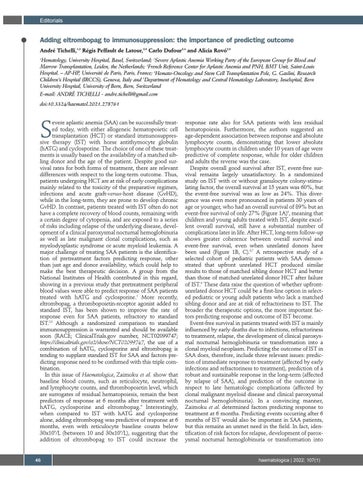Editorials
Adding eltrombopag to immunosuppression: the importance of predicting outcome André Tichelli,1,2 Régis Peffault de Latour,2,3 Carlo Dufour2,4 and Alicia Rovó2,5 1
Hematology, University Hospital, Basel, Switzerland; 2Severe Aplastic Anemia Working Party of the European Group for Blood and Marrow Transplantation, Leiden, the Netherlands; 3French Reference Center for Aplastic Anemia and PNH, BMT Unit, Saint-Louis Hospital. – AP-HP, Université de Paris, Paris, France; 4Hemato-Oncology and Stem Cell Transplantation Pole, G. Gaslini, Research Children’s Hospital (IRCCS), Genova, Italy and 5Department of Hematology and Central Hematology Laboratory, Inselspital, Bern University Hospital, University of Bern, Bern, Switzerland E-mail: ANDRÉ TICHELLI - andre.tichelli@gmail.com doi:10.3324/haematol.2021.278761
S
evere aplastic anemia (SAA) can be successfully treated today, with either allogeneic hematopoietic cell transplantation (HCT) or standard immunosuppressive therapy (IST) with horse antithymocyte globulin (hATG) and cyclosporine. The choice of one of these treatments is usually based on the availability of a matched sibling donor and the age of the patient. Despite good survival rates for both forms of treatment, there are relevant differences with respect to the long-term outcome. Thus, patients undergoing HCT are at risk of early complications mainly related to the toxicity of the preparative regimen, infections and acute graft-versus-host disease (GvHD), while in the long-term, they are prone to develop chronic GvHD. In contrast, patients treated with IST often do not have a complete recovery of blood counts, remaining with a certain degree of cytopenia, and are exposed to a series of risks including relapse of the underlying disease, development of a clinical paroxysmal nocturnal hemoglobinuria as well as late malignant clonal complications, such as myelodysplastic syndrome or acute myeloid leukemia. A major challenge of treating SAA patients is the identification of pretreatment factors predicting response, other than just age and donor availability, which could help to make the best therapeutic decision. A group from the National Institutes of Health contributed in this regard, showing in a previous study that pretreatment peripheral blood values were able to predict response of SAA patients treated with hATG and cyclosporine.1 More recently, eltrombopag, a thrombopoietin-receptor agonist added to standard IST, has been shown to improve the rate of response even for SAA patients, refractory to standard IST.2,3 Although a randomized comparison to standard immunosuppression is warranted and should be available soon (RACE; ClinicalTrials.gov number, NCT02099747; https://clinicaltrials.gov/ct2/show/NCT02099747, the use of a combination of hATG, cyclosporine and eltrombopag is tending to supplant standard IST for SAA and factors predicting response need to be confirmed with this triple combination. In this issue of Haematologica, Zaimoku et al. show that baseline blood counts, such as reticulocyte, neutrophil, and lymphocyte counts, and thrombopoietin level, which are surrogates of residual hematopoiesis, remain the best predictors of response at 6 months after treatment with hATG, cyclosporine and eltrombopag.4 Interestingly, when compared to IST with hATG and cyclosporine alone, adding eltrombopag was predictive of response at 6 months, even with reticulocyte baseline counts below 30x109/L (between 10 and 30x109/L), suggesting that the addition of eltrombopag to IST could increase the
46
response rate also for SAA patients with less residual hematopoiesis. Furthermore, the authors suggested an age-dependent association between response and absolute lymphocyte counts, demonstrating that lower absolute lymphocyte counts in children under 10 years of age were predictive of complete response, while for older children and adults the reverse was the case. Despite overall good survival after IST, event-free survival remains largely unsatisfactory. In a randomized study on IST with or without granulocyte colony-stimulating factor, the overall survival at 15 years was 60%, but the event-free survival was as low as 24%. This divergence was even more pronounced in patients 30 years of age or younger, who had an overall survival of 89% but an event-free survival of only 27% (Figure 1A)5, meaning that children and young adults treated with IST, despite excellent overall survival, still have a substantial number of complications later in life. After HCT, long-term follow-up shows greater coherence between overall survival and event-free survival, even when unrelated donors have been used (Figure 1B, C).6,7 A retrospective study of a selected cohort of pediatric patients with SAA demonstrated that upfront unrelated HCT produced similar results to those of matched sibling donor HCT and better than those of matched unrelated donor HCT after failure of IST.8 These data raise the question of whether upfrontunrelated donor HCT could be a first-line option in selected pediatric or young adult patients who lack a matched sibling donor and are at risk of refractoriness to IST. The broader the therapeutic options, the more important factors predicting response and outcome of IST become. Event-free survival in patients treated with IST is mainly influenced by early deaths due to infections, refractoriness to treatment, relapse, the development of clinical paroxysmal nocturnal hemoglobinuria or transformation into a clonal myeloid neoplasm. Predicting the outcome of IST in SAA does, therefore, include three relevant issues: prediction of immediate response to treatment (affected by early infections and refractoriness to treatment), prediction of a robust and sustainable response in the long-term (affected by relapse of SAA), and prediction of the outcome in respect to late hematologic complications (affected by clonal malignant myeloid disease and clinical paroxysmal nocturnal hemoglobinuria). In a convincing manner, Zaimoku et al. determined factors predicting response to treatment at 6 months. Predicting events occurring after 6 months of IST would also be important in SAA patients, but this remains an unmet need in the field. In fact, identification of risk factors for relapse, development of paroxysmal nocturnal hemoglobinuria or transformation into
haematologica | 2022; 107(1)







